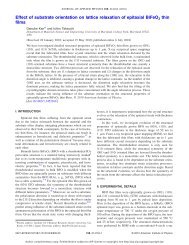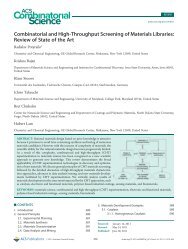Spring 2011 - Materials Science and Engineering - University of ...
Spring 2011 - Materials Science and Engineering - University of ...
Spring 2011 - Materials Science and Engineering - University of ...
You also want an ePaper? Increase the reach of your titles
YUMPU automatically turns print PDFs into web optimized ePapers that Google loves.
patinas with the Smithsonian’s<br />
Museum Conservation<br />
Institute (see sidebar).<br />
Since its announcement,<br />
the project has been covered<br />
by the Baltimore Sun,<br />
<strong>Materials</strong> Performance,<br />
<strong>and</strong> the <strong>University</strong><br />
<strong>of</strong> Maryl<strong>and</strong>’s Terp<br />
magazine. When<br />
the NSF SCIART<br />
program was<br />
highlighted at<br />
the March <strong>2011</strong><br />
national meeting<br />
<strong>of</strong> the American<br />
Chemical Society,<br />
the team was<br />
invited to a special<br />
symposium sponsored<br />
by the Getty Conservation<br />
Institute (GCI). According<br />
to Phaneuf, the team’s presentation was<br />
enthusiastically received, drawing questions<br />
from the audience, including GCI director<br />
Giacomo Chiari.<br />
In April <strong>2011</strong> the National <strong>Science</strong><br />
Foundation’s <strong>Science</strong> Nation web site, which<br />
highlights scientific discoveries for the public,<br />
debuted a video segment about the project<br />
called “Silver Saver,” narrated by former<br />
CNN chief technology <strong>and</strong> environment<br />
correspondent Miles<br />
O’Brien. To watch<br />
the video online,<br />
visit www.<br />
nsf.gov/<br />
news/<br />
special_<br />
reports/<br />
science_<br />
nation or our<br />
department’s YouTube<br />
channel at www.youtube.<br />
com/materialsatumd.<br />
Marquardt Studies Patinas at<br />
Smithsonian Institution<br />
MSE graduate student Amy Marquardt, advised by Pr<strong>of</strong>essor Ray<br />
Phaneuf, spent the summer <strong>of</strong> 2010 at the Smithsonian Institution’s<br />
Museum Conservation Institute (MCI), where she worked with<br />
Smithsonian research scientist Dr. Edward Vicenzi <strong>and</strong> MSE adjunct<br />
pr<strong>of</strong>essor Dr. Richard Livingston (NIST) on a project that could help<br />
museums better analyze, clean <strong>and</strong> preserve their bronze artifacts.<br />
The research focused on patinas, the greenish films that form on<br />
untreated metal surfaces (typically copper, bronze, <strong>and</strong> brass) after<br />
years <strong>of</strong> exposure to the elements—for example, a patina is what gives<br />
the Statue <strong>of</strong> Liberty its minty color. Patinas help protect metal against<br />
further corrosion, <strong>and</strong> may increase an object’s value. An artificial patina<br />
can also be applied to an object to accelerate the process, produce a<br />
desired look, or restore a patina after cleaning. Artificial patinas, however,<br />
are not as stable <strong>and</strong> long lasting as the real thing.<br />
“In the field <strong>of</strong> conservation, cleaning <strong>and</strong> repatination <strong>of</strong> bronze statues<br />
is an active area <strong>of</strong> research,” Marquardt explains, “but the chemistry <strong>and</strong><br />
mineralogy <strong>of</strong> the artificial patinas used by artists <strong>and</strong> conservators have<br />
not been systematically <strong>and</strong> quantitatively investigated. The purpose <strong>of</strong><br />
our research was to underst<strong>and</strong>, at the molecular <strong>and</strong> microstructural<br />
level, the relationship between the application <strong>of</strong> artificial patination<br />
to bronze <strong>and</strong> the resulting appearance <strong>and</strong> stability <strong>of</strong> the patina.<br />
Underst<strong>and</strong>ing both the process <strong>and</strong> its result is important for the<br />
conservation <strong>and</strong> restoration <strong>of</strong> bronze objects.”<br />
Marquardt <strong>and</strong> her colleagues used scanning electron microscopy,<br />
electron probe microanalysis, <strong>and</strong> Raman spectroscopy to determine<br />
patina color, mineralogy, stability <strong>and</strong> interactions with protective<br />
coatings for different artificial bronze patina recipes.<br />
Marquardt also worked with corrosion samples taken from Auguste<br />
Rodin’s Eve, a sculpture belonging to the Philadelphia Museum <strong>of</strong> Art. Her<br />
goal was to characterize the corrosion in order to aid conservators in the<br />
restoration <strong>and</strong> cleaning <strong>of</strong> the piece.<br />
“The best thing about the internship was that the nature <strong>of</strong> the project<br />
required an interdisciplinary collaboration between<br />
materials science, conservation,<br />
art history, <strong>and</strong><br />
mineralogy,” she says<br />
<strong>of</strong> the experience.<br />
“It was very<br />
interesting<br />
<strong>and</strong> I enjoyed<br />
meeting <strong>and</strong><br />
working with<br />
the scientists<br />
<strong>and</strong> conservators<br />
at the Smithsonian<br />
<strong>and</strong> NIST.”<br />
7












